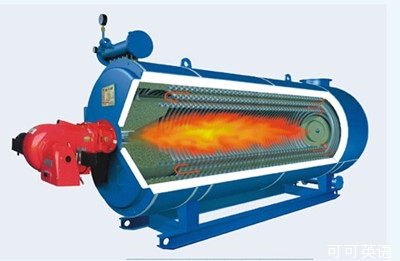(单词翻译:单击)
中英文本
Science and technology
科学技术
Channelling heat
导热
Good conduct
优质传导
It may soon be possible to control heat flows with great precision
可能很快人们就有可能如臂使指地控制热量流动了
HEAT, as every schoolboy knows, moves in three ways:conduction, convection and radiation.
每个学生都知道,传热方式有三种:传导、对流和辐射。
Convection is the mass movement of a fluid: hot water rising, for example.
对流是一种流体的大规模活动。比方说水加热温度上升,
Radiation is simply infra-red light.
红外线简单来说就是辐射。
Engineers know how to control both of these reasonably well.
工程人员对如何控制这两种传热方式相当了解。

Conduction, however, is most similar to the transmission of sound.
然而传导从原理上讲与声音传送最为相似。
It is caused, in other words, by atoms vibrating and passing such vibrations on to their neighbours.
也就是说,传导是由原子振动和原子传导这种振动活动将热量传递到临近物质。
Until now, controlling the conduction of heat through solid objects has been a tricky engineering challenge.
直到现在,如何控制固体物质间的热传导仍然是一个棘手的工程难题。
But, by making the analogy with sound explicit, Martin Maldovan, an engineer at the Massachusetts Institute of Technology, thinks he may have found a way of doing so.
但通过对声学公式的类此推导。麻省理工学院的工程师,马丁.马尔多文认为他可能找到控制热传导的方法。
Dr Maldovan's invention, published in Physical Review Letters, is based on the idea of a sonic filter.
《物理评论快报》上发表了马尔多文的研究文章。他从一种音速过滤器上受到启发。
A good way to filter sound—to eliminate certain frequencies while allowing others through—is to transmit the sound waves through a crystal.
过滤器声波的好办法之一是利用水晶体传递声波—能在声波通过时降低特度频率并允许其它频率的声波通过。
The size of the gaps between the crystal's atoms will govern which frequencies can pass.
水晶原子之间的空隙面积能决定了那种频率的声波可以通过。
Moreover, the path the sound takes can be controlled by introducing deliberate flaws into the crystal's atomic lattice. These flaws act as waveguides, channelling the sound energy along themselves.
此外,在水晶格中的特定裂纹可以控制声波传送的路径。这些裂缝工作原理如电波导,使声波在空隙中。
One difference between sound and heat is that most sound waves have low frequencies, vibrating only a few thousand times a second, whereas most heatwaves have high frequencies, vibrating trillions of times a second.
声与热的区别之一是一大部分的声波频率较低,一秒钟振动次数仅为几千次,而大部分热波频率很高,一秒钟振动次数可达几万亿次。
In general, low frequencies propagate farther than high ones.
在原理上讲,低频率比高频率振动传播要远。
This is why previous researchers had a difficult time trying to send heat through crystal lattices.
这就是为什么以前的研究在尝试将热能传过水晶格时会遇到困难。
Dr Maldovan, however, realised that although most heat is high-frequency, some has frequencies that approach those of sound.
然而,马尔多文意识到尽管大部分热波频率振动很高,但仍有一些热波振动频率与声波振动频率相近。
He theorised that if the highest-frequency waves were stripped away, it might be possible to control the remainder.
他提出起一种理论:如果把最高频率的热波剥离开后,那么控制剩下低频热波就是有可能的。
To test this idea, he grew crystals of silicon that contained tiny particles of germanium in their lattices.
为了验证他的这一理论,马尔多文配制了晶格中含有极小微粒锗的硅晶体。
The layouts of these crystals scattered and blocked high-frequency heatwaves but allowed low-frequency waves through.
硅晶的布局分散,在阻隔高频率热波的同时允许低频率波通过。
These remaining waves had frequencies in a range of 100 billion to 300 billion vibrations a second.
这些留下的热波频率在一秒一千亿到三千亿振动幅度之间。
They were still heatwaves and carried warmth, but because their frequencies were lower they behaved much more like sound.
他们仍为热波且含有热量,但他们频率低至与声波大致相同。
And Dr Maldovan could control the heat's path in waveguides as tightly as that of sound waves.
这使得马尔多文能在电波导上控制热波传递路径,就像控制声波传导那样精确。
Though turning these crystals into practical products will require further tinkering, Dr Maldovan thinks they will be immediately useful in the construction of thermoelectric materials, which transform waste heat into electricity, and will ultimately lead to the thermal equivalent of diodes, allowing heat circuits analogous to electrical ones to be built.
尽管把这些硅晶体转换为实际产品仍需要进一步研究,但马尔多文认为在热电站建筑材料上,这些硅晶体肯定能立即显示出作用。它能将废热转换为电力,进而最终形成热当量二极管,使像电循环那样形成热循环。
Where that would lead, no one knows. But it is worth bearing in mind that it was the ability to control convective heat, via the steam engine, which powered the industrial revolution. Controlling conductive heat might have equally unforeseen consequences.
这一技术会演化成什么,还无人知晓,但值得我们思考的是,通过引发工业革命的蒸汽汽轮机可以控制对流热。同样,控制传导热能或许会为我们带来无法预见的结果。
词语解释
1.be possible to 可能
Will it ever be possible to model arctic sea-ice decline accurately?
建立北冰洋冰层融化的数理模型,究竟有无可能?
Fossil melanosomes mean it might be possible to work out what those dinosaurs looked like, too.
黑素体的化石表明,想要弄清楚这些恐龙长什么样也是有可能的。
2.similar to 与...同样的;如同
You should see something similar to figure 2.
你应该会看到类似图2的内容。
Try and visualize this energy as a bright white light similar to that of sunlight.
试着想象这一能源,把它当做一种明亮如阳光一样的白光。
3.based on 以…为依据
It's based on personal relationships and trust.
它建立的基础是私人关系和信任。
The boom is based on solid foundations.
经济荣景建立在坚实的基础。
4.in general 通常;大体上;一般而言
That's a good rule for life in general.
一般来说这是一个很好原则。
Three explanations apply in general, however.
然而,这种现象通常有三种解释。


